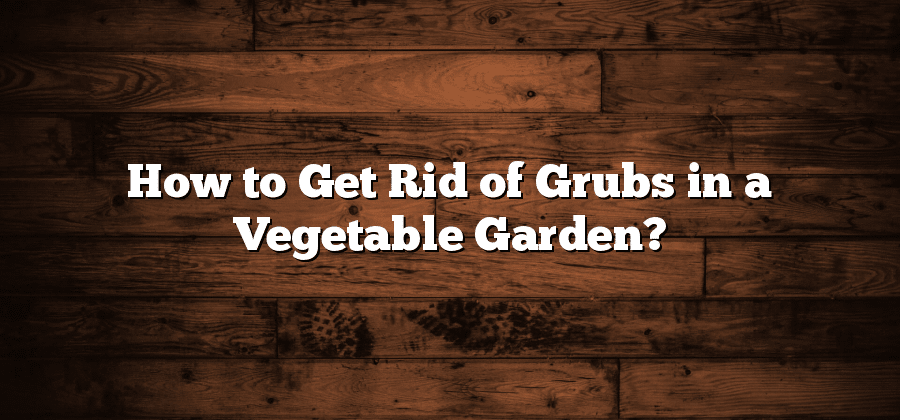Identifying Grub Infestation in Your Vegetable Garden
Grubs, the larvae of beetles, are a common problem in vegetable gardens. These small, cream-colored creatures have soft bodies with distinct C-shaped segments. Their presence can often go unnoticed, as they tend to hide beneath the soil surface during the day and feed on the roots of your plants at night. However, there are a few telltale signs that can help you identify a grub infestation in your vegetable garden.
One of the first signs of a grub infestation is the sudden wilting or yellowing of your plants, despite adequate watering. This is because grubs feed on the roots, causing the plants to become weak and deprived of essential nutrients. You may also notice bare patches or uneven growth in your garden, as grubs consume the roots and disturb the soil structure. Additionally, if you dig a little deeper into the soil around the affected plants, you may find the grubs themselves, typically within the top few inches of soil. Identifying these signs early on can help you take prompt action to prevent further damage and protect the health of your vegetable garden.
Understanding the Lifecycles of Garden Grubs
The lifecycle of garden grubs is a fascinating process that occurs underground, out of sight to most gardeners. These pests, also known as larvae, typically belong to various beetle species such as Japanese beetles, June bugs, or chafer beetles. Understanding their lifecycles can be crucial in effectively controlling their population and minimizing damage to your vegetable garden.
The lifecycle of garden grubs starts with an adult beetle laying eggs in the soil during the spring or early summer months. These eggs hatch into tiny, white grubs that feed on plant roots. As they grow, their size increases, and they go through several stages known as instars. In each stage, the grubs molt and shed their exoskeletons, growing larger and stronger. This destructive feeding period can last for several months before they enter a pupa stage, in which they transform into adult beetles and emerge from the soil once again.
Creating a Healthy and Balanced Garden Ecosystem
Creating a healthy and balanced garden ecosystem is essential for long-term success in maintaining a thriving vegetable garden. One key aspect of this is promoting biodiversity within your garden. By cultivating a wide variety of plants, you can attract a range of beneficial insects and birds that will help keep pest populations in check. Additionally, planting flowers and herbs that attract pollinators such as bees and butterflies can enhance the overall health and productivity of your garden.
Another important element in creating a healthy garden ecosystem is proper soil management. It is crucial to maintain good soil fertility by regularly adding compost or organic matter. This not only provides essential nutrients for plants but also improves soil structure and drainage. Implementing crop rotation practices can also help prevent the buildup of pests and diseases in the soil, as different plants have different nutrient requirements and attract different pests. Overall, cultivating a healthy and balanced garden ecosystem will not only reduce the need for chemical interventions but also create a more sustainable and harmonious environment for your vegetables to thrive.
Implementing Natural Predators to Control Grub Population
One effective approach to control grub population in your vegetable garden is by implementing natural predators. These predators can play a crucial role in keeping the grub population in check without the need for chemical interventions. By introducing beneficial insects, such as ground beetles, birds, or nematodes, you can create a balanced ecosystem where these predators can actively feed on grubs and limit their growth.
Ground beetles are particularly effective in controlling grub infestations. These nocturnal creatures are known to consume large numbers of grubs, thus helping in reducing their numbers. Additionally, birds can also be encouraged to visit your garden by providing them with birdhouses or feeders, as they are natural predators of grubs. Another natural predator that can be used in combating grub infestations is the use of nematodes. These microscopic organisms are parasitic to grubs and can infect and kill them. By incorporating these natural predators into your gardening practices, you can significantly reduce the impact of grubs on your vegetable garden.
Utilizing Organic and Chemical-Free Control Methods
One of the most environmentally-friendly approaches to controlling grub populations in your vegetable garden is by utilizing organic and chemical-free methods. These methods prioritize the health of your plants, the well-being of beneficial insects, and the safety of your family and pets.
A common technique is handpicking grubs off the leaves and stems of your plants. Although it can be time-consuming, this method allows you to physically remove the grubs and prevent further damage to your crops. Additionally, adding beneficial nematodes to the soil is an effective way to combat grub infestations. These microscopic organisms naturally occur in the soil and prey on various garden pests, including grubs. By introducing nematodes into your garden, you can take advantage of their natural instinct to seek out and eliminate grubs without the use of any harmful chemicals.






